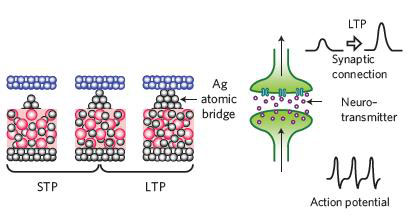| Sep 15, 2011 |
Inorganic synapses - Atomic nano-switches emulate human memory
|
|
(Nanowerk News) In a breakthrough, researchers at the International Center for Materials Nanoarchitectonics (MANA) demonstrate for the first time the key features in the neuroscience and psychology of memory by a AgS2 synapse ("Short-term plasticity and long-term potentiation mimicked in single inorganic synapses").
|
|
Artificial neural networks have attracted attention as a means to a better understanding of biological neural networks, as well as aiding developments in artificial intelligence. The complex and interconnected nature of thought processes make neural behavior difficult to reproduce in artificial structures without software programming. Now Takeo Ohno and researchers at the International Center for Materials Nanoarchitectonics (MANA), Tsukuba, Japan, and the University of California have mimicked synaptic activity with the electro-ionic behavior of a nanoscale AgS2 electrode.
|
 |
| CAPTION
|
|
The researchers observed a temporary higher-conductance state in the AgS2 system following an incident electric pulse. Repetition of the input pulse over two second intervals led to permanently higher conductance. These two responses mimic the short-term plasticity and long-term potentiality in biological synapses.
|
|
In the most widely accepted 'multistore' model of memory in human psychology, new information is stored briefly as a sensory memory. Rehearsal converts short-term memory to long-term. When demonstrating memorization of the numerals '1' and '2' in a 7 × 7 inorganic synapse array, the behaviour of the artificial synapse indicated 'multistore' memory rather than a conventional switch.
|
|
The researchers add, "The data indicate that we may apply a psychlogical memory model simultaneously with the emulation of biological synaptic-like behaviour."
|

